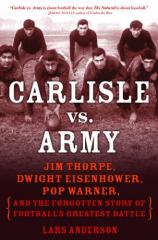Carlisle Vs. Army: Jim Thorpe, Dwight Eisenhower, Pop Warner and the Forgotten Story of Football’s Greatest Battle
Review
Carlisle Vs. Army: Jim Thorpe, Dwight Eisenhower, Pop Warner and the Forgotten Story of Football’s Greatest Battle
If sports is a metaphor for life, then the history of sports serves as a reminder for how athletic competition has shaped our nation in many more venues than playing fields.
CARLISLE VS. ARMY by Lars Anderson is a story rich in the successes and failures of American history, told with a cast of characters that includes three Presidents of the United States, the generals who led America to victory in World War II, football legends whose influence on the game is still felt today, and finally --- and perhaps most importantly --- the proud Indian nations who deserved better from the white men who seized control of their lands.
At the end of the 19th century, the United States government still had not resolved the conflict created by westward expansion. Indian tribes across the nation fought to retain their tribal ways of life, but the military might of the U.S. army was too much for the Indian nations. Defeat and death of young warriors threatened the existence of Indian tribes. The American government, with the support of many Indian leaders, commenced a strategy designed to “elevate” Indians by immersing them in the white man’s ways. One way to accomplish this goal was to create Indian Schools, modeled of course after American institutions of learning. One such institution was the Carlisle Indian Industrial School founded in 1879 in Carlisle, Pennsylvania. Indian children from across the nation were brought to the school with the hope that they would learn the ways of the white man.
The creation of the Carlisle School coincided with the birth of college football. As many colleges began to field teams, Richard Pratt, the founder of the Carlisle School, wanted a football team for two reasons. Pratt thought that the discipline and spirit created by a football program would benefit the Indian youth attending Carlisle. He also believed that the inherent athletic ability of Indians would be demonstrated on the football field and establish to the nation that Indians could be the equal of whites. Pratt was a prescient man who understood the role that athletics could play in bringing minority groups into the mainstream.
Carlisle would become a college football powerhouse in the early 1900s. While the Indian athlete would be responsible for this success, Carlisle would also owe their good fortunes to the brilliance of Glen “Pop” Warner, a football genius whose innovations are still part of the college game today and whose name adorns a youth football program known across the land.
By the time a young running back named Jim Thorpe came to Carlisle, the football team was already established as an eastern power. Indeed Carlisle was perhaps the first truly national power. They would travel across the country for games because many football fans wanted to see the Indians play. As early as the first decade of the 20th century, college football was establishing itself as a major source of financial gain for athletic programs. Crowds of 40,000 to 50,000 were not unusual for Carlisle games.
As the title suggests, CARLISLE VS. ARMY culminates with the account of the game between the two schools remembered for its impact on the “mythical” national champion selected in that era, not by a Bowl Conference Championship but by one man, Walter Camp. The Army football team chronicled by Anderson is noteworthy not for its football prowess but for the fact that players on the team included Dwight Eisenhower and Omar Bradley. The West Point class of 1914 that battled Carlisle on the football field would become the most famous class in West Point history. Every graduate of the class who stayed in the military would attain the rank of General.
CARLISLE VS. ARMY is a book that transcends the football game that spawns its title. It’s about the birth of a sport that is now arguably the most popular in America and about athletes who take the lessons of sports and apply them to life. You need not be a football fan to appreciate the insights offered by Anderson in this superb account of America in the beginning of the 20th century. This absorbing chronicle of college football reminds us once again of the impact the game has on our lives.
Reviewed by Stuart Shiffman on August 28, 2007
Carlisle Vs. Army: Jim Thorpe, Dwight Eisenhower, Pop Warner and the Forgotten Story of Football’s Greatest Battle
- Publication Date: August 28, 2007
- Genres: History, Nonfiction, Sports
- Hardcover: 368 pages
- Publisher: Random House
- ISBN-10: 140006600X
- ISBN-13: 9781400066001




